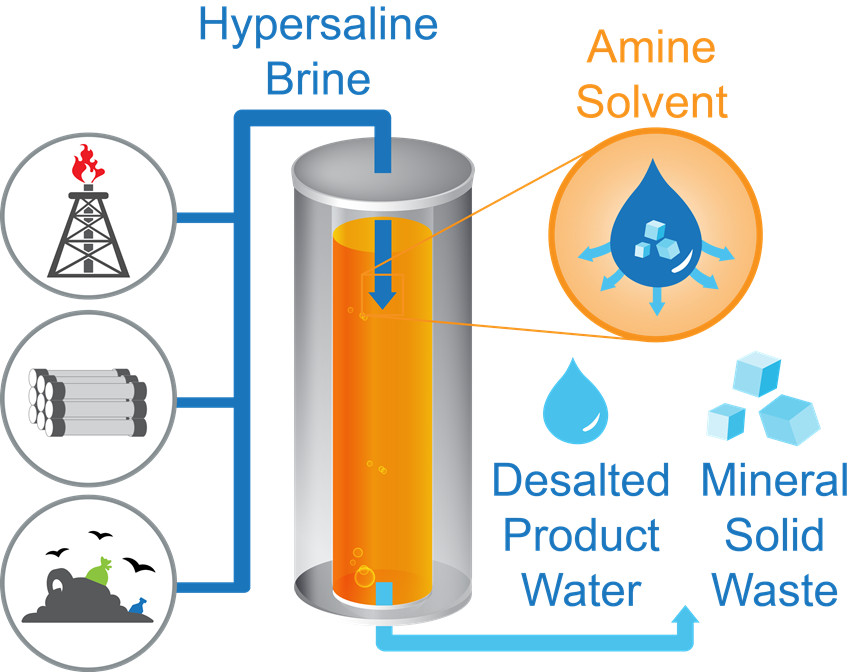A novel approach to make seawater evaporate faster than freshwater has been hailed as a significant breakthrough in desalination technology that will benefit billions of people worldwide.
Tag: Desalination
3D-Printed Microstructure Forest Facilitates Solar Steam Generator Desalination
Faced with the world’s impending freshwater scarcity, researchers in Singapore turned to solar steam generators, which are emerging as a promising device for seawater desalination. The team sought design inspiration from trees and harnessed the potential of 3D printing.
NUS scientists develop a new class of artificial water channels for more efficient industrial water purification
Scientists from the National University of Singapore have successfully synthesised a special protein-mimic that can self-assemble into a pore structure. When incorporated into a lipid membrane, the pores permit selective transport of water across the membrane while rejecting salt (ions).
Don’t wait, desalinate: new water purification system cuts cost, energy expenses
A water purification system created by researchers at the Beckman Institute for Advanced Science and Technology separates salt and unnecessary particles with an electrified version of dialysis. Successfully applied to wastewater, the method saves money and saps 90% less energy than its counterparts.
Novel solar desalination system for remote areas
With summer temperatures soaring, the spectre of water scarcity looms large. As a possible solution to increase the availability of clean, potable water, researchers at the Indian Institute of Science (IISc) have developed a novel thermal desalination system which can work using solar energy.
From seawater to drinking water, with the push of a button
MIT researchers have developed a portable desalination unit, weighing less than 10 kilograms, that can remove particles and salts to generate drinking water.
Science Snapshots From Berkeley Lab
Science Snapshots From Berkeley Lab – Water purification, infant-warming device, cuff-based heart disease monitor, ancient magnetic fields
Sunlight to solve the world’s clean water crisis
Researchers at The University of South Australia’s Future Industries Institute have developed technology that could eliminate water stress for millions of people, including those living in many of the planet’s most vulnerable and disadvantaged communities.

Chula Engineering Cures Salty Tap Water with NanoTech
During the dry season this year, Bangkok residents have faced the saltiest tap water problem in 20 years as a result of global warming and seawater rise. Chulalongkorn engineers predict the problem to persist until May and have proposed solutions with desalination technology.

Researchers measure, model desalination membranes to maximize flow, clean more water
A team of researchers — including engineers from Iowa State University — have used transmission electron microscopy and 3D computational modeling to quantify and visualize why some desalination membranes work better than others.

Going with the flow
LLNL researchers have created carbon nanotube (CNT) pores that are so efficient at removing salt from water that they are comparable to commercial desalination membranes. These tiny pores are just 0.8 nanometers in diameter. In comparison, a human hair is 60,000 nanometers across.
How clean water technologies could get a boost from X-ray synchrotrons
In a new perspective, SLAC and University of Paderborn scientists argue that research at synchrotrons could help improve water-purifying materials in ways that might not otherwise be possible.

Unorthodox Desalination Method Could Transform Global Water Management
Over the past year, Columbia Engineering researchers have been refining their unconventional desalination approach for hypersaline brines—temperature swing solvent extraction (TSSE)—that shows great promise for widespread use. The team now reports that their method has enabled them to attain energy-efficient zero-liquid discharge of ultrahigh salinity brines—the first demonstration of TSSE for ZLD desalination of hypersaline brines.

Polluted Wastewater in the Forecast? Try A Solar Umbrella
Evaporation ponds, commonly used in many industries to manage wastewater, can occupy a large footprint and often pose risks to birds and other wildlife, yet they’re an economical way to deal with contaminated water. Now researchers at Berkeley Lab have demonstrated a way to double the rate of evaporation by using solar energy and taking advantage of water’s inherent properties, potentially reducing their environmental impact. The study is reported in the journal Nature Sustainability.